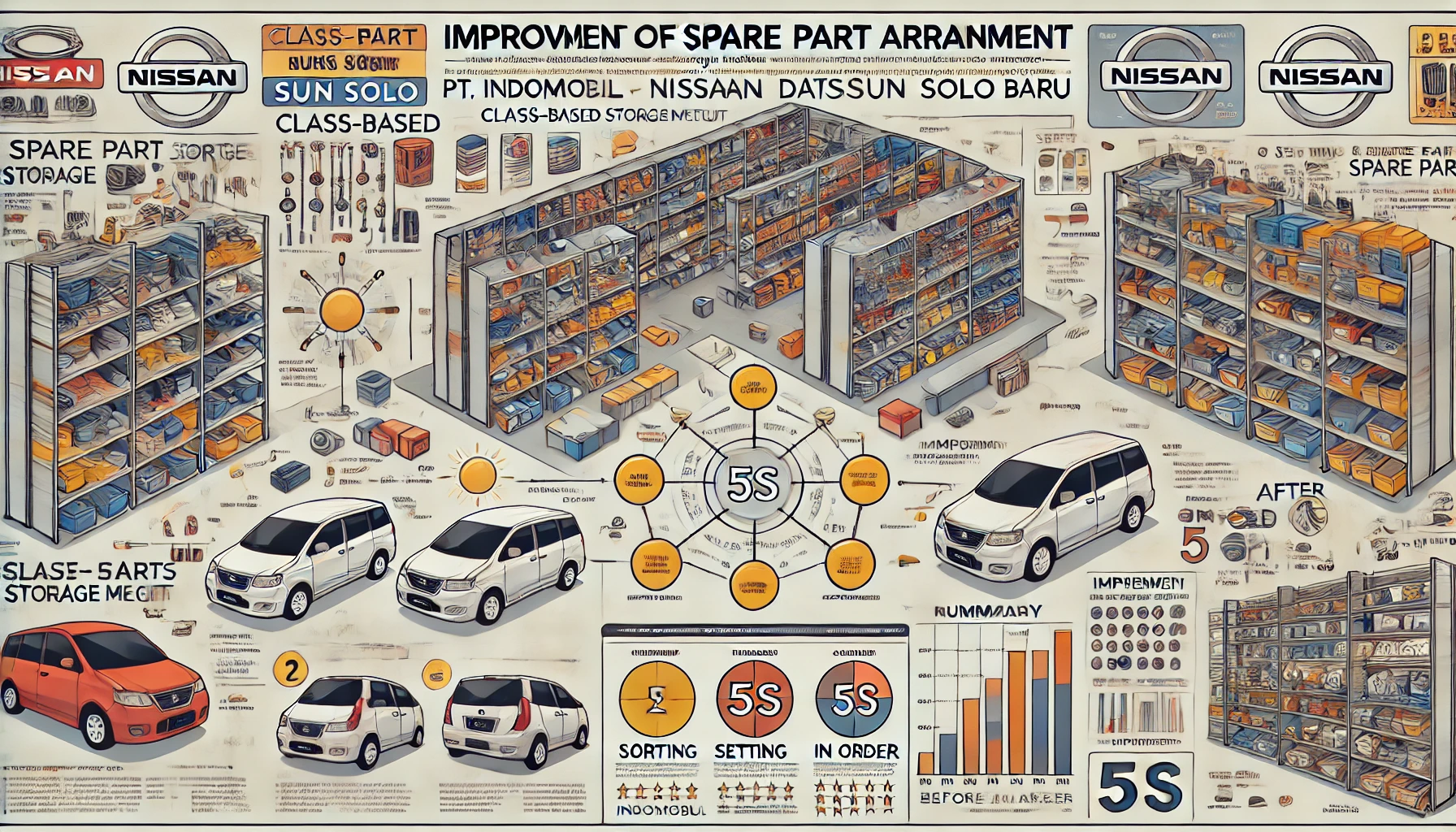Improvement of Spare Part Arrangement with Class Based Storage Method and 5s Method in Spare Part Room PT. Wahana Sun Solo (Indomobil Nissan Datsun Solo Baru)
DOI:
https://doi.org/10.21831/jamat.v1i1.815Keywords:
improvement, Class based storage, 5S method, Spare partAbstract
The aims of the improvements made in the spare part room at PT. Wahana Sun Solo were to: (1) organize the spare parts storage area based on specifications; and (2) increase effectiveness and work efficiency in locating spare parts while creating a work area that adheres to the 5S method standards set by Nissan Motor Indonesia (NMI).
The improvements in the spare part room were implemented through several processes: identifying the spare part room layout, redesigning the storage system using a class-based method, updating labels, and designing the improvement of the 5S method. Testing was conducted by performing a time study and a partman movement study focused on locating three sample spare parts: brake pads, air filters, and fan belts. An assessment index was conducted using an evaluation sheet after the improvements were made.
The class-based storage method improvement created a more organized arrangement of spare parts according to types. Updates to labeling and enhancements to the 5S method significantly improved the partman's effectiveness and efficiency. Testing demonstrated that the time required to locate brake pad samples resulted in an efficiency increase of 144%, improvement of 218% for air filters, and improvement of 182% for fan belts. Observations showed that, on average, the partman's search required 5 fewer steps for brake pads, 7 fewer steps for air filters, and 5 fewer steps for fan belts compared to the pre-improvement process. In addition, the observation on the movements involved in locating spare parts resulted in reduced movements by at least two movements. The assessment sheet completed after the improvement yielded an assessment index of 91.2%.
Downloads
References
[1] A. M. Sukma, "Kemenperin Sebut Industri Otomotif Indonesia Tumbuh Pesat Lampaui Global!", Bisnis.com, Feb. 20, 2023. [Online]. Available: https://otomotif.bisnis.com/read/20230220/275/1630048/kemenperin-sebut-industri-otomotif-indonesia-tumbuh-pesat-lampaui-global.
[2] Y. Hasan, "Pengaruh Kualitas Jasa Pelayanan Bengkel Terhadap Kepuasan Konsumen (Studi Kasus Cv. Kombos Service Station Toyota Sudirman)," IAIN Manado, 2020.
[3] F. A. Sase and N. M. Lysandra, "Analisis Kepuasan Pelanggan Servis Pada Dealer Mobil 3S," Jurnal Teknologi dan Manajemen, vol. 20, no. 2, pp. 149–156, 2022.
[4] Azizi et al., "Design and fabrication of intelligent material handling system in modern manufacturing with industry 4.0 approaches," International Robotics & Automation Journal, vol. 4, no. 3, pp. 1–10, 2018. DOI: 10.15406/iratj.2018.04.00149.
[5] G. A. Putra, "Manajemen Pergudangan Dan Penataan Gudang Sparepart Alat Ukur Filtrasi Oil dan Gas Di PT Sinergining Adhi Selaras Menggunakan Metode 5S dan ABC," Jurnal Optimasi Teknik Industri (JOTI), vol. 2, no. 1, pp. 24–29, 2020.
[6] H. Zulfikar, D. R. Saputra, A. Maulana, Y. A. Cahyono, and S. Sahara, "Peningkatan efisiensi operasional pergudangan melalui teknologi canggih," Jurnal Ilmiah Wahana Pendidikan, vol. 9, no. 16, pp. 393–402, 2023.
[7] H. Juliana and N. U. Handayani, "Peningkatan kapasitas gudang dengan perancangan layout menggunakan metode class-based storage," J@ti Undip: Jurnal Teknik Industri, vol. 11, no. 2, pp. 113–122, 2016.
[8] I. Khadijah and A. Kusumawardhani, "Analisis pengukuran kerja untuk mengoptimalkan produktivitas menggunakan metode time and motion study," Diponegoro Journal of Management, vol. 5, no. 3, pp. 1126–1240, 2016.
[9] H. Heizer and B. Render, Principles of Operations Management. Pearson Educación, 2004.
[10] R. B. Adi, "Analisis Studi Waktu dan Gerak Kerja Operator Produksi Doilies menggunakan Metode Stopwatch dan Therblig (Studi Kasus PT. XYZ)," Universitas Islam Indonesia, 2024.
[11] Z. Iftikar, R. Anggawisastra, and J. H. T. John, Teknik Tata Cara Kerja. Bandung: TI-ITB, 1979.
[12] A. N. Sapoetra, "Cara menghitung kuesioner skala Likert," Retrieved Jun. 12, 2018.
[13] A. F. Ahmad, "Perancangan Tata Letak Gudang Bahan Baku Dengan Metode Class-Based Storage Dan Penataan Yang Ergonomis," Global Shadows: Africa in the Neoliberal World Order, vol. 44, no. 2, pp. 8–10, 2006.
[14] "Warehouse Layout and Design: Tips for an Efficient and Optimized Operation," Cadre Technology, Mar. 5, 2023. [Online]. Available: https://www.cadretech.com/blog/warehouse-layout-and-design-tips-for-an-efficient-and-optimize-operation.
[15] B. Rahardjo, "Perancangan sistem manajemen gudang material penunjang di PT XYZ," J@ti Undip: Jurnal Teknik Industri, vol. 12, no. 2, pp. 127–136, 2017.
[16] Y. Monden, Sistem Produksi Toyota Suatu Ancangan Terpadu, untuk Penerapan Just-In-Time. Jakarta: CV Teruna Gravika, 1995.
[17] D. P. Restuputri and D. Wahyudin, "Penerapan 5S (Seiri, Seiton, Seiso, Seiketsu, Shitsuke) Sebagai Upaya Pengurangan Waste Pada Pt X," Jurnal Sistem Teknik Industri, vol. 21, no. 1, pp. 51–63, 2019.

Downloads
Published
How to Cite
Issue
Section
License
Copyright (c) 2024 Journal of Automotive and Mechanical Applied Technology

This work is licensed under a Creative Commons Attribution 4.0 International License.








